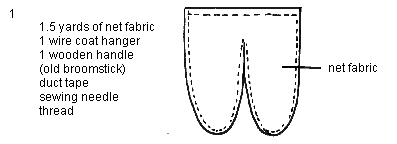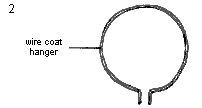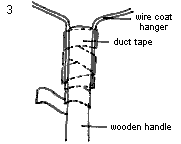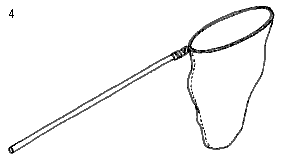Collecting Arthropod Specimens
Part of the Biodiversity Counts Curriculum Collection.
"It depends on what you are trying to find out. If you want to know what insects are living on this particular plant or this particular site, you have to be quite thorough in your methods. You can't just go in there and see what you can catch. You have to choose collection methods that are suited to the vegetation on your site and that target the sorts of bugs that live there," he told us.
He recommended visiting the site before you begin collecting. "Get a handle on what's there before you begin so you can bring the right equipment when it's time to collect."
He listed six of the main collection methods and explained what sort of terrain and specimens they were best suited to.
1. Aerial netting
An aerial net with a long tapered tail is made of a lightweight mesh. It is used to collect organisms on the top of flower heads and other vegetation. "It tends to catch aerial insects, lots of flies particularly. You don't really hit the vegetation," Kefyn explained. "You just very quickly sweep over it, and insects feeding or resting on the vegetation will fly up into the net. You need to flick your wrist at the end of each sweep to close the mouth of the net."
Nets are available from biological supply houses, but they are also cheap and easy to make yourself.




2. Sweep netting
According to Kefyn, this is one of the best ways to catch a lot of organisms. "The classic habitat for using a sweep net is a meadow," he told us. A sweep net is heavier and shallower than the aerial net and has a wider mouth. "It's usually made of sailcloth or canvas, rugged enough not to be torn by the leaves and other vegetation that usually wind up in it, along with the bugs," Kefyn said. "It's good for catching heavier arthropods: beetles, spiders, true bugs, and such. You sweep the vegetation itself and end up catching arthropods that actually live in and on the plants." With either type of net, sweep as many times as necessary to get a good sample. "In some habitats, you might have to sweep 20 or 30 times. In others, you do four sweeps, and your net is full of organisms," Kefyn explained.
3. Beating
This method is good for sturdier vegetation, such as trees and shrubs. "You tap the plant with a stick and catch whatever falls off in a large tray, a sheet, or an upturned umbrella. You can also do it with flowers—tap gently—if you don't want to harm them by using the sweep net," Kefyn suggested.
4. Hand collecting
"With some very delicate plants and flowers—milkweed, for example—you don't want to go sweep netting or tapping them, or you'll destroy the plant. But if you want to collect bugs living on them, the aerial net won't do." That is when hand collecting is a good choice, Kefyn said. A soft paintbrush or cotton swab could be used to gently knock the specimen into a collecting vial, or it could be carefully picked off by hand. Turning over stones and logs exposes many arthropods—beetles, spiders, centipedes, sowbugs—and hand collecting is the method of choice. "The best strategy is to take turns with two people since there are often too many specimens for one person to catch, and you have to be fast before they run and hide," Kefyn advised. "Also check any webbing for spiders hiding there," he added.
5. Pitfall trapping
Another way to catch soil dwellers is to set up a pitfall trap. Get a smooth-sided container like a soda bottle cut in half or a large margarine tub. Dig a hole (save the soil to replace later) and put the container in it. The top of the container should be level with the ground. You can put some crumpled paper or an inch or so of water in the bottom of the container. If you want to try a baited trap, meat scraps, decaying fruit, or molasses mixed half with water all work well. Each type of bait attracts different arthropods, so use only one type of bait at a time.
Place four or five small stones around the top of the container and put a piece of wood or heavy cardboard on the stones. Make sure you leave space for the arthropods to drop in. Put another handful of stones on top of the board to hold it down. Let the trap sit for a few hours or overnight, then check to see what you have caught. Try experimenting with different baits to see if they attract different arthropods.
"This is a wonderful method for catching ground-living arthropods. You'll catch things with this method that you won't catch in any other way," Kefyn said. Make your pitfalls by digging round holes with a bulb planter or trowel and sinking a plastic cup in each. The hole should be deep enough so the rim of the cup is level with the ground. Pour about an inch of water with a drop of liquid laundry detergent into each cup. Check the cups every few days and remove the specimens that have fallen into your traps. The water will evaporate and the specimens will rot if you leave them more than two or three days.
6. Berlese funnel
Many tiny arthropods make their homes in leaf litter, rotting wood, or soil. They can be coaxed to leave their habitat if you make conditions uncomfortable enough (but not lethal). Since their preferred habitat is dark, cool, and moist, you can force them out by applying light and heat. Gather a small sample (in a small bucket or bag) of leaf litter, wood, or soil. Indoors, set up a contraption called a Berlese funnel. These are available from biological supply houses, too, but are easy to put together yourself.
If your site is at the edge of a wood or is in a wood itself, leaf litter will yield a rich harvest, according to Kefyn. "That's where the greatest diversity is, period. Typically, in a woodland, you'll get several thousand individual organisms out of a square-meter site."
Kefyn defines leaf litter as fallen leaves and anything else that has accumulated in a wooded area for several years.
You can rig up a Berlese funnel device using a large coffee can with a plastic funnel inside and a metal grid over the top. Put the litter on top of the grid and cover it with another coffee can with a light in it. After a few days, the heat and the dryness will force the arthropods down the funnel and into your collection container.
"Most of what you collect will be very small—soil mites, springtails, that sort of thing," Kefyn said. He advises using a paintbrush to remove the tiniest arthropods from the collection container. "You will need a stereomicroscope with a good top light to sort this material," he advised.
No matter which method you choose, Kefyn said it is important to decide ahead of time what you plan to do with your specimens. "There's no point catching the things if you don't know what to do next."
When it comes to the debate on whether to collect or not, Kefyn votes for killing specimens, then identifying, labeling, and preserving them in a collection.
"You can't study arthropods in any meaningful way without collecting them," he argues. "Whereas drawings and photographs done in the field are very useful aids for memory and a great help in close observation, they have limited usefulness in taxonomy. Experts can't identify them without the specimen. I can't persuade somebody that I have a new species of spider, for example, by sending a picture of it. He or she wants to see the specimen."
Other Methods for Collecting Arthropod Specimens
A lot of insects are attracted to yellow. A yellow pan trap is a quick and easy way to catch them. Set out a yellow pan or bowl and fill it with an inch or two of water. Add of few drops of detergent to break the surface tension. You can either set the bowl on the ground or place it into a small hole so that its top is level with the ground. Insects that are attracted to yellow (some flies, wasps, and beetles) will fall in and drown. It is important to check the pan traps every day because insects begin to decompose quickly in water. Transfer the insects to jars of alcohol or dry and pin them promptly.